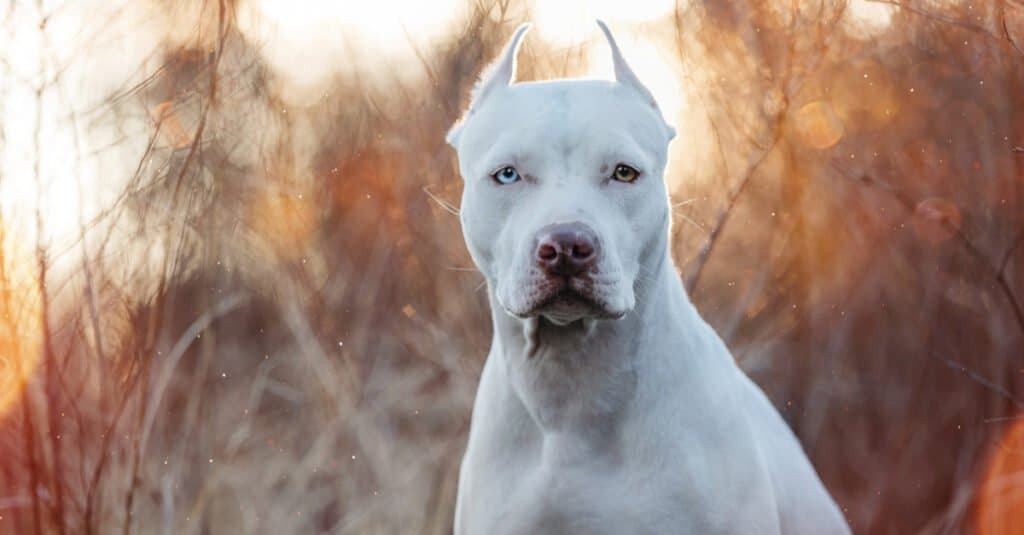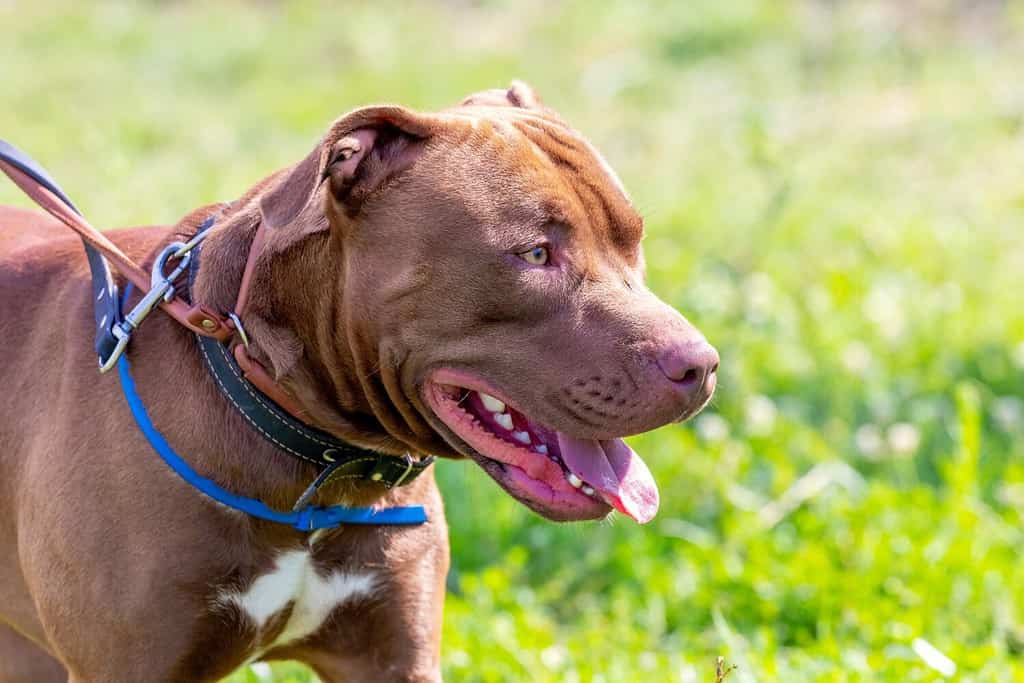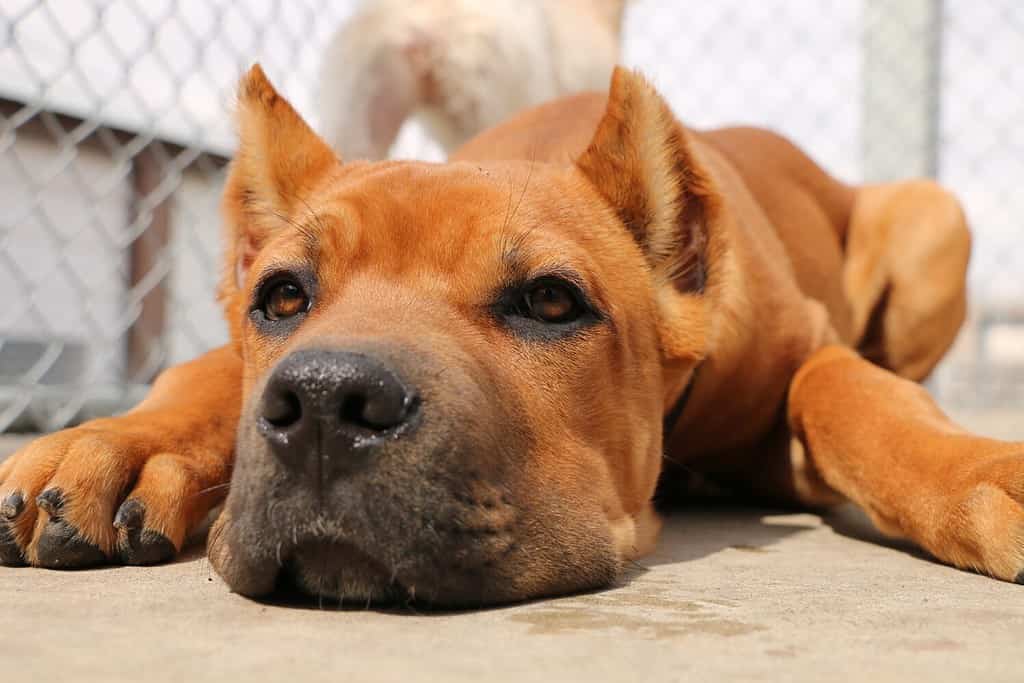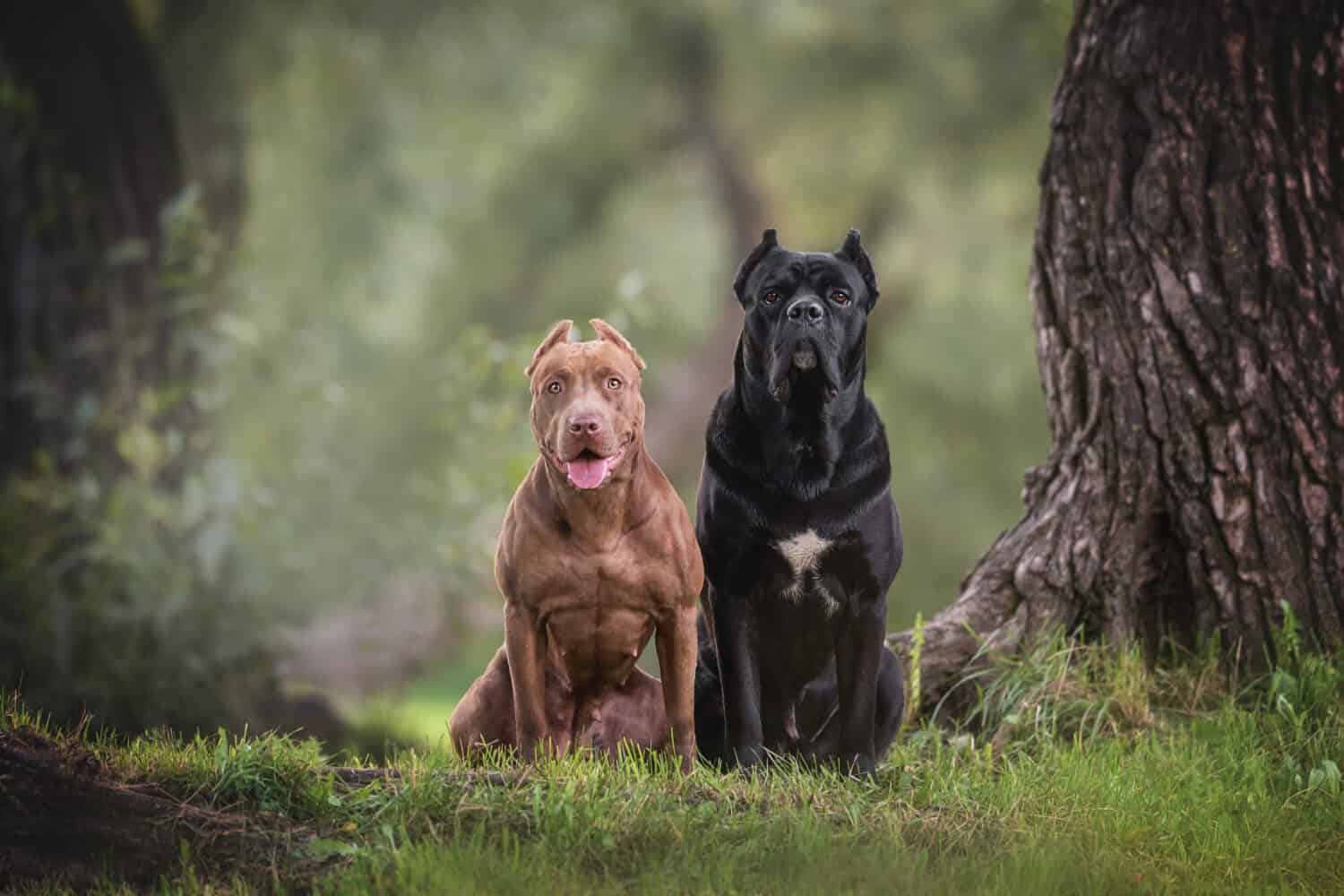The American pit bull terrier/cane corso mix, known as the American pit corso or the corso pit bull, comes on strong with their chiseled body, but their quick smile gives them away – they are gentle giants. While any mixed breed comes with surprises, these pups pair best with families with all the time in the world to play and engage. They are stubborn yet intelligent and seem to have the best of both worlds. Look to see everything you need to know about the corso pit bull.
History of the Corso Pit Bull

The cane corso used to be a part of wartime protection, but mixing it with an
American pit bull terrier
gives it a gentler demeanor.
The reputation of both of these species as guard dogs is one of many qualities that makes the American pit bull terrier and cane corso easy to love. While some sources paint these dogs as fighters, the right socialization and training set them on a path to success. A loving home makes this mix sweet and doting on their family, and the only drive to fight comes from a desire to protect the ones they love.
The American pit bull terrier’s lineage comes from many other muscular breeds, including the bull terrier and the American Staffordshire terrier. These dogs primarily found their homes as bait for decades, but a ban in 1835 outlawed it.
The life of a cane corso was much different, working to guard property and cattle on farms. Originally bred in Italy, some experts say that their bloodline goes back to Roman war dogs, and their ruthless hunting skills meet their match when up against large game. As these farming methods became obsolete, the species diminished, but dog enthusiasts started to revive the population in the 1940s. They didn’t make their way to the United States until the end of the 20th century, and they received recognition from the American Kennel Club in 2010.
The Muscular Build of the Corso Pit Bull
With any mixed breed, the specific weight tends to range with the same variation as the dogs that make it up. On average, the American pit corso stands 24-34 inches tall, weighing 50-115 lbs. The only way to truly determine this adult dog’s size is by looking at its biological parents.

Some owners choose to crop the cane Corso’s ears to reduce their floppiness.
©Sbolotova/Shutterstock.com
The coat of both dogs is short with a soft shine for the sleek but coarse fur, though some variations have a double coat for the winter. Brindle coloring is common, but the American pit corso also has black, fawn, or red fur. Genetically, the corso pit bull typically has a skull and muzzle that resembles the American pit bull terrier, while its body and stature follow the look of the cane corso. Their shoulders and chest are squarish, complemented by their equally muscular and thick neck.

The American pit bull terrier has a similarly muscular build to the cane corso, making potential health issues and physical needs easy to predict.
©OlesyaNickolaeva/Shutterstock.com
With a muscular and deep chest, this dog is stocky. Their fur naturally grows short, but it is not as dense as similar dogs. The coat is not waterproof, and they have a large physique that needs a durable home. Sometimes, these dogs don’t know their size, making oversized cuddles necessary. While some owners crop the ears of these dogs, leaving them alone only adds to their bright grins and baggy jowls.
Corso Pit Bull: A Lovingly Protective Personality
Since the AKC officially registered the American pit corso, its naturally protective nature has gained popularity among families. Young people need socialization to make them comfortable with people and reduce the risk of aggression. Once owners establish this baseline of behavior, they remain loyal to their master, quickly responding to commands and attention they receive. While both species sometimes lean towards aggression, learning to stop this habit is a job for their master.

Much like the American pit bull terrier, the corso pit bull enjoys time with its family, but they aren’t much of a natural fighter.
©MVolodymyr/Shutterstock.com
Some say the American pit corso struggles to share attention with other dogs and animals in the home, but a little training helps. They love a home with many children, blending well with the family atmosphere that shows them the same love in return. Don’t let the muscular build fool you – they are sweet and doting when they feel safe.
As much love as the Corso pit bull shows his family, strangers get a much colder shoulder. If this pup senses anything wrong, it jumps to protect its family, though not as quickly as the cane corso does. Instead of becoming physically aggressive, they bark as a warning when feeling threatened. This personality is big, so they thrive when they have a family to spend time with. Separation anxiety is a struggle for this dog, but owners get a warm and boisterous welcome whenever they walk in the door.

The cane corso parent has tons of energy, but they want nothing more than to wait for their family to return home.
©Alisha Falcone/Shutterstock.com
Corso Pit Bull’s Health Concerns: Hip Dysplasia and Heart Disease
The Corso pit bull’s breeding for optimal genetics makes it healthy, but the right veterinary care prevents the damage that comes with some of its health concerns. Both parent breeds put it at risk of developing hip and elbow dysplasia, which puts their hips at risk of popping out of the socket. The only way to correct this problem is with surgery.
Much like other dogs with their build, cardiac issues like dilated cardiomyopathy plague this breed. This condition depends on how severe the progression is when identified, and most dogs need to be medicated by their vet to help.
Allergies and other minor concerns arise, depending on genetics and how you care for them. These dogs live to be 10-14 years old with proper care.
Taking Your Corso Pit Bull Home: Upkeep and Regular Care
Coat

Thanks to the two parent breeds, the American pit corso has a short coat with a lot of shine. You need to regularly groom this dog’s stiff hair to eliminate the massive amount of fur it sheds. Brushing him weekly provides enough stimulation and care to manage this code, though a stiff brush is the only way to rid it of loose hair truly. Luckily, they keep themselves fairly clean already. While it is far from hypoallergenic, giving this dog a weekly bath keeps it clean without robbing the skin of natural oils that protect it.
With thrice weekly brushing sessions for teeth, you keep their teeth from succumbing to decay or dreaded bad breath. Their nails grow slowly, so trimming twice monthly is enough to keep them from clicking along your tile or wood floors. By establishing a consistent grooming routine, these dogs get used to the care to make the process easier.
Exercise and Social Interactions
This muscular build needs to be put to beneficial use to keep the American pit corso healthy. They like almost any physical activity you could take them to, including swimming, tugging, and running, though they have to be fairly exhausted to turn down a game of fetch. Whether his family is single or whole, any owner needs to have time to spend with them to keep them happy.
Training and socialization are the keys to establishing good behavior, even when this dog has nearly limitless space to explore. Regardless of how well they do, keep this dog on a leash to avoid dangerous altercations with unfamiliar dogs. The Corso pit bull doesn’t start fights, but they are ready to stand up for themselves. This dog is highly intelligent, so they need a leader who understands how to train these strong-willed beauties.

Both cane corso and American pit bull terrier adults love to run and play, and using this energy reduces the risk of behavioral issues.
©Sbolotova/Shutterstock.com
Daily exercise is necessary, so the American pit corso needs at least an hour of vigorous play to use its energy, ranging from a long jog or a trip to the park. No matter how you engage this pup, they’re ready to join.
Training
As beautiful and vivacious as the American pit corso is, this pup requires some training to control its stubborn stream. While a Pit Bull offers a well-suited match for any novice dog owner, the cane corso is the opposite, so splitting the difference in the middle with the Corso pit bull is a fair expectation. Being strict and consistent is the best way to get commands across to them, teaching them that they won’t see rewards for wild behavior.
While strictness helps, give your dog a safe space to become used to other people and animals. Seeing these other interactions builds confidence, making the dog more protective in the right ways with its intelligence. If you have to leave this dog alone, crate training or other housebreaking skills need to be added to this training.
With moderate energy, the American pit corso needs space to run outside but secure the yard to keep them from running away. Getting outside for an hour is enough stimulation to keep them happy. This energy expenditure also helps them focus during training, which is challenging for most patient owners.
Diet
Once an adult, the corso pit bull goes through about 2-3 cups of food daily. Multiple meals fuel the muscles safely and sufficiently. Shop for the best kibble available for all-day energy and the ideal balance of nutrients. Large-breed kibble has different nutrients than you need for smaller dogs, so be careful in choosing the food that works for them.

Apart from kibble, these dogs enjoy protein sources like meat and cheese. Some owners prefer an entirely raw diet for their dog, though splitting it with kibble gives them the most variety they need. Since the size of this dog varies greatly, multiply its weight by 20 calories of food per pound to determine the best amount. A 50-lb. corso pit bull needs at least 1,000 calories, while larger 115-lb. dogs need over double. A similar metric of 1 ounce per pound of body weight determines the water they need.
Ready to discover the top 10 cutest dog breeds in the entire world?
How about the fastest dogs, the largest dogs and those that are -- quite frankly -- just the kindest dogs on the planet? Each day, AZ Animals sends out lists just like this to our thousands of email subscribers. And the best part? It's FREE. Join today by entering your email below.
Thank you for reading! Have some feedback for us? Contact the AZ Animals editorial team.








